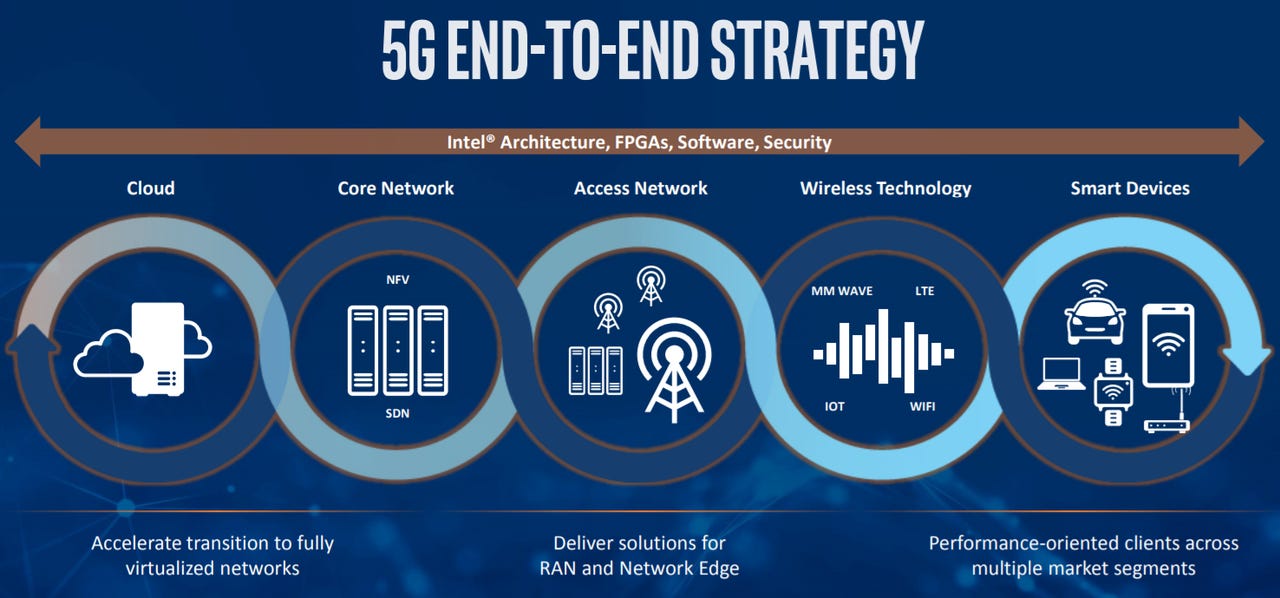MWC 2018: Intel and Huawei showcase 5G interoperability


Intel has announced that it will use Mobile World Congress (MWC) 2018 to conduct the world's first 5G New Radio (5G NR) over-the-air interoperability public demonstration with Huawei, using the new 3GPP 5G NR non-standalone (NSA) standards set at the end of last year.
"It will be a fully compliant connection, and that's important because since the standard was just voted on in December, obviously there's only so much time to be able to develop a solution that can support and be fully compliant to every feature in the specifications," Intel GM of 5G Advanced Technologies Rob Topol told media.
Read also: Samsung to unveil Galaxy S9 at MWC
MWC 2022
Topol referred to Intel's flexible programmable processor platform, saying it allows the company to change and develop the systems as 5G standards evolve.
Intel is now involved in more than 25 5G trials worldwide, he added, and is focused on real-world testing such as at the current PyeongChang Winter Olympic Games in South Korea.
"We are, if it's not obvious, a company that does the primary work of our field testing outside the lab. We take our assets, our prototypes, our products into real-world conditions -- in Korea, we're in subzero temperatures. We're supporting 5G millimetre-wave based lengths, providing connectivity," he said.
"We take our solutions out of the lab and focus on field testing, we see that as the most important way to make sure that those solutions are ready. And it also gives consumers, partners, OEMs, [and] networking infrastructure vendors opportunities to also test and work together. And our efforts have been broad across network, cloud, and clients."
According to Topol, Intel can rapidly prototype and trial its solutions thanks to being a single vendor that can offer everything from the cloud level, down to the device level.
"We expect to see not only significant traffic up through core networks and cloud, but we do expect a high amount of machine-to-machine communication and communication that happens just on the edge of the network. And that's why at Intel we've been actively pursuing trials, prototyping, product development in all of these segments," he said.
Huawei had announced partnering with Intel on interoperability trials based on 3GPP standards back in September.
The companies used Huawei's 5G base station prototype and Intel's third-generation 5G Mobile Trial Platform to test 5G NR across the sub-6GHz spectrum band -- including the C-band between 4GHz and 8GHz -- and the higher-range millimetre-wave (mmWave) spectrum bands.
President of Huawei's 5G Product Line Yang Chaobin had previously said that the networking company has already tested C-Band, mmWave, and downlink-and-uplink decoupling 5G technologies in Beijing.
Huawei has also previously worked with Intel on delivering cloud and network function virtualisation (NFV) solutions to enable telcos to upgrade while laying the foundations for 5G.
Disclosure: Corinne Reichert will travel to MWC in Barcelona as a guest of Huawei
Related Coverage
Samsung's Galaxy S9: Everything we know so far
Samsung will announce the Galaxy S9 at MWC in just a few days. Here's everything we currently know about the upcoming smartphone.
Huawei announces 5G trial in Vancouver
Huawei has announced attaining single-user speeds of 2Gbps during trials of 5G customer premises equipment with Telus in Vancouver, using mmWave spectrum, Massive MIMO, F-OFDM, and polar coding.
Ericsson completes 5G carrier solution
Ericsson has upgraded its radio portfolio using the 5G NR standards set by 3GPP in December, claiming a complete carrier solution.
The 5G revolution is here: What business needs to know (TechRepublic)
TechRepublic's Conner Forrest explains three things IT pros need to know about 5G, next-gen high-speed wireless tech.
5G mobile networks: A cheat sheet (TechRepublic)
As LTE networks become increasingly saturated, mobile network operators are planning for the 5G future. Here is what business professionals and mobile users need to know about 5G.
Intel unveils Xeon D-2100 processors
Intel's fastest low-power edge computing processors.
Intel will soon stop being a PC-centric company
Intel has been trying to reduce its dependence on the PC business by moving into data-centric businesses such as the Internet of Things, which includes automated driving. These made up 47 percent of revenues in fiscal 2017, so in the next few years, the PC could become a minority.
Mobile device computing policy (Tech Pro Research)
Mobile devices offer convenience and flexibility for the modern workforce-but they also bring associated risks and support issues. This policy establishes guidelines to help ensure safe and productive mobility.